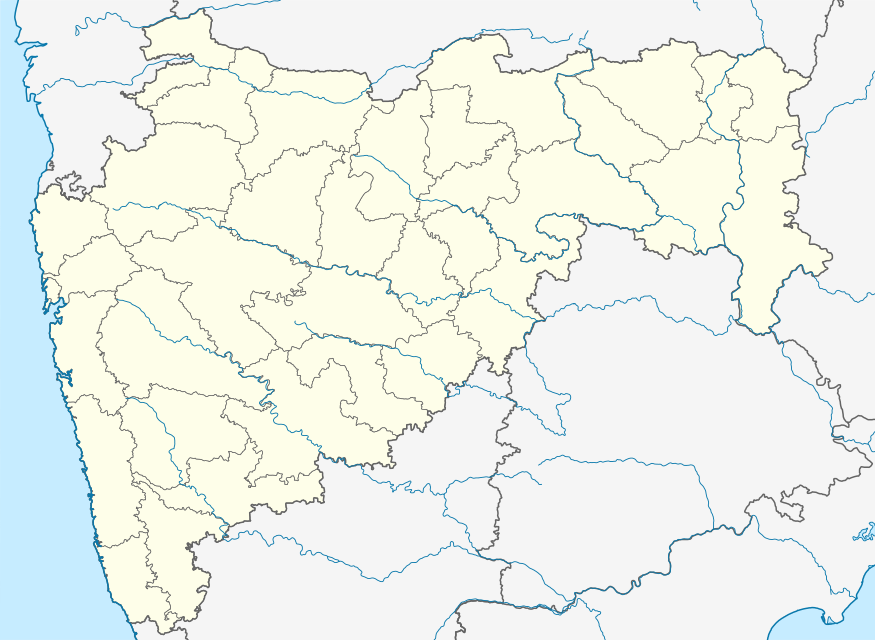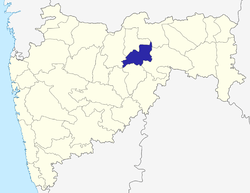Mangrulpir
Mangrulpir is a city with Municipal council in Washim district in the Indian state of Maharashtra. Mangrulpir is a religious place where both Hindu and Muslim live together. Mangrulpir is also known as Mangrulnath. Because of Shree Birbalnath Maharaj Mandir, The great Saint.Every year it meets Shree Birbalnath Maharaj Yatra / Fair . Mangrulpir is also famous for Pir Dada Hayat Qalandar's Dargah. Thus, Mangrulpir Has Unity in Diversity.
Mangrulpir Mangrulnath Mangrulnath | |
|---|---|
City | |
 Mangrulpir Location in Maharashtra, India | |
| Coordinates: 20.3167°N 77.35°E | |
| Country | |
| State | Maharashtra |
| District | Washim |
| Named for | Pir Dada Hayat Qalandar |
| Government | |
| • Type | Municipal council |
| Area | |
| • Total | 35 km2 (14 sq mi) |
| Area rank | 2nd in washim |
| Elevation | 429 m (1,407 ft) |
| Population (2011) | |
| • Total | 1,34,983 |
| • Rank | 2nd in washim |
| • Density | 7,155/km2 (18,530/sq mi) |
| Demonym(s) | mangrulkar |
| Languages | |
| • Official | Marathi |
| Time zone | UTC+5:30 (IST) |
| PIN | 444403[1] |
| Vehicle registration | MH-37 |
| Website | www |
Location
Mangrulpir city is located in Washim district. The city is 40 km from district headquarter and 671 km from state capital Mumbai. It is an important city in the district. Mangrulpir Tahsil has a strong rural network.
Situation
The. headquarters of the Tahsil bearing the same name is situated in 200 15 north latitude and 770 20' east longitude about 39 miles to the south-east of Akola, the district headquarters. It is an electrified municipal town with a population of 14087 as per file Census of 1971. The police station at Mangrulpir has jurisdiction extending over 119 villages. The court of the Civil Judge. Junior Division is also located there. Being the headquarters of the sub-division alongwith the tahsil, are situated in Mangrulpir the offices of the Deputy Collector (Sub-Divisional Officer) and the Tahsildar. A panchayat samiti has also been established at Mangrulpir and as such there is the office of the Block Development Officer located in the town. The town has a post and telegraph office and a Government rest house. Wells form the main source of water supply. At times scarcity of water is felt. The medicial facilities are provided by the primary health centre conducted by the Zilla Parishad and private medical practitioners. Besides the primary schools conducted by the Zilla Parishad, the Government Multi-purpose High School and the Qualandriya Urdu High School cater to the educational needs of the town populace. The branch of the Akola District Central Co-operative Bank Ltd, is located in the town. The weekly market is held at Mangrulpir on even Saturday.
Municipality
The municipality was established at Mangrulpir in 1959 and is governed under the Maharashtra Municipalities Act, 1965. It covered an area of 11.76 square km. The municipal council is composed 10 members with no scat reserved either for the scheduled castes or the scheduled tribes, or for women.
The total receipts of the Maugrulpir municipality in the year 1961-62 came to Rs. 73,634 of which an amount of Rs. 7,984 was the receipts from municipal taxes, the per capita municipal tax being Rs. 0.79. The total expenditure incurred by the municipality during the same period was Rs. 66,619.
The total income of the municipality during the year 1965-66 [In 1073-74 the income expenditure amounted to Rs, 5,45,000 and Rs. 5,16,000, respectively.] was Rs. 1.21,730 and was composed of municipal rates and taxes, Rs. 42,175; revenue derived from municipal property and powers apart front taxation. Rs. 3,967; grants and contributions from the Government, Rs. 51,996 and income from miscellaneous source's, Rs. 23,592.
The total expenditure of the municipality during the same year came to Rs. 1,18,009 and comprised general administration, Rs. 7,102: collection charges. Rs. 3,543; public safely Rs. 7,472: public health and convenience, Rs. 27,015; public works, Rs, 2.745; public instructions Rs 55,634 and miscellaneous expenditure, Rs. 14,498,
History
Mangrulpir has long been the head of a pargana, and was possibly at one time a Muhammedan settlement of some importance, but it has been rather insignificant for many years. The municipality at Mangrulpir is the youngest in the district having been established as late as 1959. The antiquity of the region round Mangrulpir goes back to two thousand years. This has been shown by a large hoard of Satavahana coins numbering more than 1.500 discovered in 1939 at Tarhala, a village about 7 miles north by west of Mangrulpir. The coins are of potin, round in shape, and have on the obverse (front side) the figure of an elephant with the trunk uplifted with the name of the Satavahana king who issued it round the edge and the Ujjain symbol (two dumbbells placed al right tingles, one across the other, on the reverse (back side). The hoard contained coins of some kings such as Kumbha Satakami, Karna Satakarni etc. who became known for the first time. They flourished in the early centuries of the Christian era. The hoard has been published by Dr. Mirashi, of the Nagpur University.
Objects of Interest
The only features of interest are the dargah , and tombs of Shah Badr-ud-din and other Muhammedan saints and pits. The town is called Mangrulpir on account of these associations. The old Akola District Gazetteer published in 1910 states, 'The actual tomb is on the top of a small hill, on which are also other buildings connected with it, while below are two large courtyards containing rooms for the accommodation of pilgrims; the whole is surrounded by a massive stone wall with nine bastions and four gates, forming a large fortification. Local tradition relates that Shah Badr-ud-din, also called Hayat Kalandar, came from Tus in Arabia in one of the Fourteen Hundred Palanquins, 652 of which actually halted at Mangrul; it is added, however, that he may have come along with the Emperor Aurangzeb, and that the time may have been 700 years ago.'
The fair is attended by about 25.000 people. The inam and the jahagir have been abolished since 1948 and now it gets a Government grant of Rs. 1,170 per annum. It owns about 200 acres of land and gets an annual income of about Rs. 2,000 from the same besides rental 'income of Rs. 2,000 per annum.
The temple dedicated to Birbalnath Maharaj who hailed from Punjab and took sumadhi on February 4, 1928 owns 25 acres of land. An annual fair is held in honour of Birbalnath Maharaj on Magha Shuddna 14-January-February. About 10 to, 12 thousand people assemble at the time of the fair.
Many other objects of interest in the town as they then existed are described in the Akola District Gazetteer. The description of the same is reproduced below as many of them have historical importance. "The jama masjid stands just below the tomb, it is a large but not very striking building. Close to the town stands the dargah of Hazrat Shah Amansahib, with that of his guru Shah Amanullah in the same enclosure. It has an inscription and is of some size, though not on the scale of Shan Badr-ud-din's dargha. Amansahib, who came from Sialkot, is of less antiquity than the other and was distinguished by adopting the penance of remaining constantly for 12 years seated on the ground. Finally the Emperor Shah Jahan came to Mangrul, and on his expressing the wish that the fakir should rise Amansahib did so, but with such pain and difficulty that the blood poured from his crippled legs; Shah Jahan then gave him two jagir villages and some inam land. A third dargah, that of Divan haji Shah Muhammad, stands two miles west of Mangrul on a hill called Dhanbaldi, treasure-hill, beside the Bashim road. This saint is said to have been a jamadar in the Nizam's service, having charge of 14 horses, but his date cannot he more definitely fixed. He came from Nasirabad in Khandesh and was greatly pleased with the tomb of Badr-ud-din, a voice from which presently bade him to relinquish all worldly interests and live at the tomb; he did so and the avaliya continued to give him directions from time to time. Thus he went to Mecca and afterwards to Burhanpur, where a saint called Shall Allah Baksh gave him a cup containing the juice of certain herbs, whereby he was purified and became himself an avaliya, again lie was directed to live 50 paces behind the dargah, where he built a mosque and dug two wells, and later to go to the site of his present tomb. While he was building a mosque and a dargah there a Gosain passed and gave him a tin of powder whereby 52 tolas of copper might be turned into the same weight of gold, but Divan Shah put it to one side. The Gosain passed again some years later and seeing the various works completed, thought his magic had been utilised, but the saint first showed him the untouched tin and then caused the Gosain to see the hill composed entirely of gold and silver, whence the present name of Dhanbaldi. Another dargah and several Hindu temples of no particular interest also stand in the town."' [4]
See also
References
- http://www.citypincode.in/MAHARASHTRA/WASHIM/MANGRULPIR_PINCODE
- "Census of India 2001: Data from the 2001 Census, including cities, villages and towns (Provisional)". Census Commission of India. Archived from the original on 16 June 2004. Retrieved 1 November 2008.
- "Population by religion community - 2011". Census of India, 2011. The Registrar General & Census Commissioner, India. Archived from the original on 25 August 2015.
- https://cultural.maharashtra.gov.in/english/gazetteer/AKOLA/places_Mangrulpir.html. Missing or empty
|title=(help)
